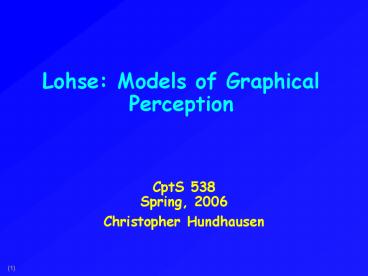Lohse: Models of Graphical Perception PowerPoint PPT Presentation
1 / 15
Title: Lohse: Models of Graphical Perception
1
Lohse Models of Graphical Perception
- CptS 538Spring, 2006
- Christopher Hundhausen
2
Who is Gerald Lohse?
- Was a member of U Penn Business School
- Published several papers in graphics and
visualization areas between 1993 and 2001 - SIGCHI
- Visualization 93
- Communications of the ACM
- Jumped ship and went to private consulting firm
in early 2000s - Appears to refocused attention on (a) the use of
graphics in marketing and on websites, and (b)
modeling consumer behavior, especially w.r.t.
websites
3
Is a Picture Worth 1,000 Words?
- The author claims yes, yet he cites literature
(Larkin Simon, 1987) that critiques this claim - At any rate, visualizations might aid
- Exploratory data analysis
- Problem solving
- Decision making
- Persuasion
- Memory and retention
- Aside (for Richard) Specific task being
performed, and context in which task is
performed, might influence which perspective
(cognitive, social, cultural) is most appropriate
as evaluation framework
4
Graphics Has Storied History
- Founding father Playfair (1800s)
- Transformed tables into charts
- Empirical evaluations of graphics date to the
1920s - WWI spurred use of graphics as basis for
strategic decisions - Business started using charts in 1930s to make
strategic decisions - What we can learn from this history
- Visualizations are for reasoning about info
- Graphics design evolved in ad hoc fashion
- There exists no common theory of effectiveness
5
Graphics Design Principles Rely on Intuition and
Experience
- Bertin (1967) Semiology of Graphics
- Efficiency amounts to the amount of viewing time
required to answer a specific question - Graphics design involves mapping retinal
variables to perceptual approaches - Retinal variables express variations in data
(position, size, saturation, texture, color,
orientation shape) - Perceptual approaches are essentially classes of
tasks to be performed w/graphics - Grouping similar items
- Distinguishing dissimilar items
- Ordering items
- Observing proportions or identifying quantities
- Each graphic should convey a single message
6
Graphics Design Principles Rely on Intuition and
Experience (cont.)
- Tufte (1983, 1990)
- Presents principled critiques of graphics within
the context of their use - Derives graphics design principles from his case
studies (but not tested empirically) - Example eliminate chart junk
- The best graphics are the simplest
- Take home message of authors review Graphics
design principles arent empirically tested
7
Empirical Studies of Graphics
- Numerous empirical studies have compared human
performance promoted by graphical designs that
vary along given dimensions (which form
independent variables) - These studies yield mixed results, as shown in
massive Table 1 (lets take a look) - Some results
- Color aids attention span, retention, and recall
better than monochrome - People prefer color
8
Aside What Theory of Effectiveness Would These
Results Support?
- Knowledge Transfer Expert understanding of data
encoded in graphic, which is then decoded by
viewer, resulting in robust transfer (goodness of
encoding impacts transfer)
9
The Problem with Empirical Studies of Graphics
- Brute force factor analysis of the goodness of
alternative graphics is unwieldy - Impractical to perform a study in every unique
situation of graphics use - Empirical studies of graphics fail in two
regards - They do not provide a priori performance
predictions, which is what designers need! - They do not connect results to the perceptual
processes that brought the results about (no
theory)
10
The Solution Predictive Models of Graphical
Perception
- A starting point Pinkers (1990) classic model
with three components - Perceptual processes
- Working memory
- Long term memory (LTM)
- Steps
- Early perceptual processes scan in image and
encode in WM (certain primitives can be scanned
in parallel, others only serially) - WM encoding (which exists for 7 sec) triggers LTM
graph schema that allows one to interpret and
comprehend graphic - (Graph schemas are learned procedures for
decoding graphics novices may lack them) - Authors comparison of 3 graphics is instructive
11
A Comparison of 7 Models
12
A Comparison of 7 Models (cont.)
13
A Comparison of 7 Models (cont.)
14
Conclusions
- Empirical studies are informative, but have
little a priori predictive value in specific
graphics-viewing situations - Cognitive modeling techniques hold promise as
predictive tools that, in some cases, can
automate graphics design - Major shortcomings of cognitive modeling
techniques that must be remedied in future work
include - An insensitivity to individual and cultural
differences - An inability to deal with novices and learning
15
Discussion Questions
- What is the problem with graphic design
guidelines? - What are some key benefits and limitations of the
graphical perception models reviewed by the
author? - Suppose you are charged with designing a graphic
to answer a specific question. Suppose further
that you know that the people who will ultimately
use the graphic will come from widely varying
cultural backgrounds. Which of the seven
graphical perception models reviewed by the
author would you apply to this problem, and why? - What are the advantages of a cognitive modeling
approach, as opposed to relying strictly on
empirical studies of human perception? - The authors main beef with many of the models is
that they are invariant to subtle variations in
the discrimination task. What does he mean by
this? - Can the graphical perception models account for
animated graphics? If not, how might they be
extended to do so?

